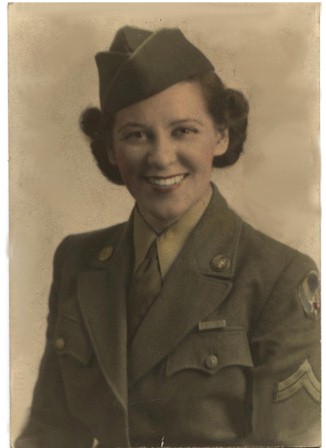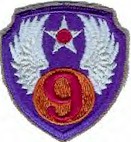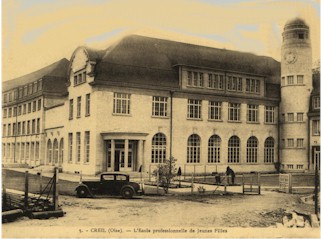
History of the Ninth
The U.S. Army Middle East Air Force as it was known was finally redesignated the Ninth Air Force on November 12, 1942 the same day the Allies landed troops in North Africa. General Brereton was in command. By this time the force had received a few fighter planes, troop carrier units and more bombers, both heavy and medium. Not much of a force, the majority of America’s resources were in England. Meager as they were in the theater at first, it was an important morale boost for the ground forces fighting there. In 1943 additional units were assigned as the United States industrial production started to kick into gear with trained pilots and more aircraft.
Out of the initial experience came the "Three Commandments" that have been the Ninth Air Force's tactical purposes even today.
1. Gain air superiority.
2. Deny the enemy the ability to replenish or replace losses.
3. Offer ground forces close support.
After success in North Africa, the Ninth took on an even more essential mission, the invasion of Sicily and the boot mainland of Italy. Bombers, fighters, troop carriers and support units were reinforced and given new designations. In just one year's time the small beleaguered Middle East Air Force had developed into a formidable air armada.
Highlights of the North Africa and Sicily campaigns must be mentioned - even in the briefest of histories. Namely, the "Palm Sunday Massacre," April 18, 1943, when Ninth Air Force fighters caught hundreds of German JU52 transports low over the water of the Mediterranean attempting to evacuate troops from North Africa. It was just that. A massacre. Axis Sally called the Ninth Air Force fighters "Butchers of the Ninth" that evening. And of course, the most famous of all, the Ploesti oil refinery raids in July 1943. Colonel John "Killer" Kane, leader of the 98th Bomb Group (B-24's), was among four Medal of Honor awardees for special heroism on that expensive but heroic mission.
In October 1943, the plan called for relocation of the Ninth Air Force to England preparatory to the "D" Day Invasion. At first the Ninth was assigned to operation "Point Blank" along with the Eighth Air Force. Mission: to smash the German Luftwaffe in the air and on the ground to bring about complete air supremacy. Medium bombers of the Eighth were reassigned to the Ninth. In effect, the plan was to perpare the Ninth's units for their major role: that of direct tactical support for ground forces in the coming invasion.
By "D" Day, June 6, 1944, the Ninth had become the largest tactical Air Force ever assembled under one command, 250,000 people with 3,500 airplanes in 1,500 units. It consisted of fighters, bombers, troop carriers, air defense, engineering and service commands.
The allies enjoyed complete Air superiority in the Normandy campaign.
General Patton's Third Army pushed through France so quickly that Patton was known to relocate his command post each evening. General Bradley during Operation Cobra put the Third Army on one road south, sending 200,000 vehicles through the narrow corridor at Avranches, risking being cut off by flanking enemy units. The flanks held - the break through was safe. This mobility of the Third Army was now a reality, superbly supported by the XIX Tactical Air Force, now commanded by Brigadier General Weyland.
With the invasion successfully accomplished, the allied juggernaut smashed across Europe from the Normandy beaches to the Elbe river in Germany. Whole enemy divisions surrendered to the Ninth in Southern France. Rommel himself was shot off the road,
 The Ninth Air Force was established on 28th June 1942, when Major General Lewis H. Brereton was placed in command of the U.S. Army - Middle East Air Force(USAMEAF). General Brereton brought twelve B-17’s with him from India. They joined a number of B-24's that were originally designated from the U.S. to used as a ferry mission to China, but were held back in the Middle East because of German General Erwin Rommel's sucesses in North Africa. The group of misbegotten aircraft were pressed into service to help the British 8th Army hold Eygpt. Colonel Halverson was the original leader of the ferry mission. At the same time a group of P-40's flew off the aircraft carrier "Ranger" off the west coast of Africa and landed in Cairo without a loss. After Rommel was halted at El Alamein, Eygpt, the importance of having heavy bombers in the theater was reinforced.
The Ninth Air Force was established on 28th June 1942, when Major General Lewis H. Brereton was placed in command of the U.S. Army - Middle East Air Force(USAMEAF). General Brereton brought twelve B-17’s with him from India. They joined a number of B-24's that were originally designated from the U.S. to used as a ferry mission to China, but were held back in the Middle East because of German General Erwin Rommel's sucesses in North Africa. The group of misbegotten aircraft were pressed into service to help the British 8th Army hold Eygpt. Colonel Halverson was the original leader of the ferry mission. At the same time a group of P-40's flew off the aircraft carrier "Ranger" off the west coast of Africa and landed in Cairo without a loss. After Rommel was halted at El Alamein, Eygpt, the importance of having heavy bombers in the theater was reinforced.
On December 2, 1945 the Ninth Air Force was inactivated while headquarters were still in Germany. In just seven months after victory, the greatest tactical Air Force in history was dismantled.
Over 1,200
WAACs assigned to the Signal Corps (ASF) worked as telephone switchboard
operators, radio operators, telegraph operators, cryptologists, and photograph
and map analysts. WAACs assigned as photographers received training in the
principles of developing and printing photographs, repairing cameras, mixing
emulsions, and finishing negatives. Women who became map analysts learned to
assemble, mount, and interpret mosaic maps. The 394th was activated in Dale, California on February 1, 1943 and was originally assigned to the 4th Air Force. The 394th was assigned to the IX Air Force Service Command in Northhold, England in February 1944. The unit was under the command of Colonel Harold W. Dutcher and initially consisted of seven officers and 161 enlisted men. In addition there were five women attached as telephone operators, this number grew steadily as men were transferred to replace casualties in the infantry. During it's 9 months in the ETO the 394th processed some one million telephone, teleprinter, courier, and radio message traffic contributing to the war effort.
FRANCE and LUXEMBOURG

 GERMANY:
Occupation and the Trip Home
GERMANY:
Occupation and the Trip Home
 They
Served with Honor : Home Page
They
Served with Honor : Home Page